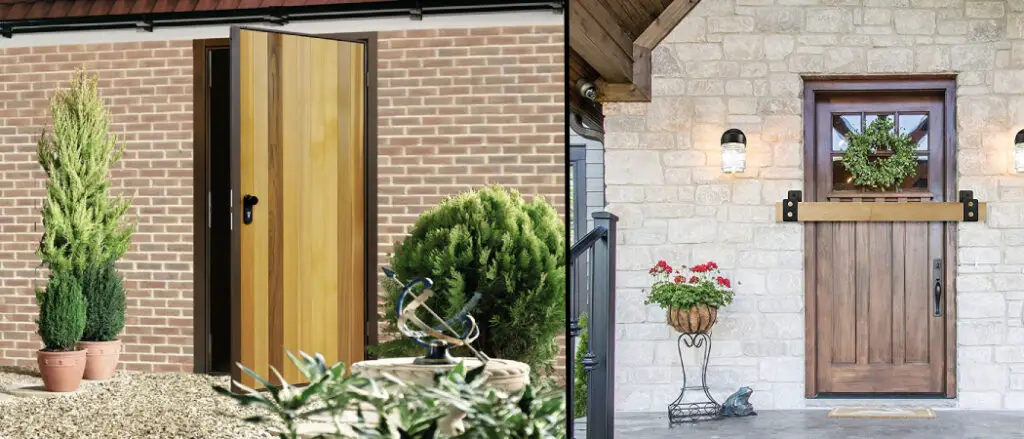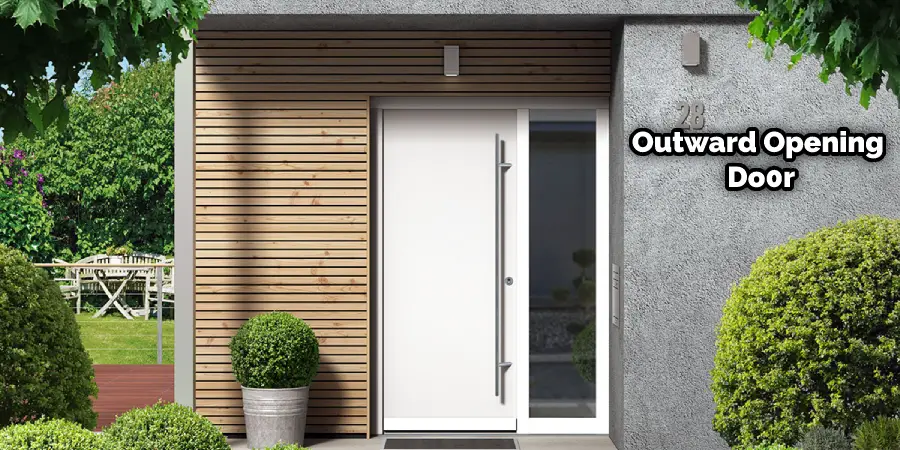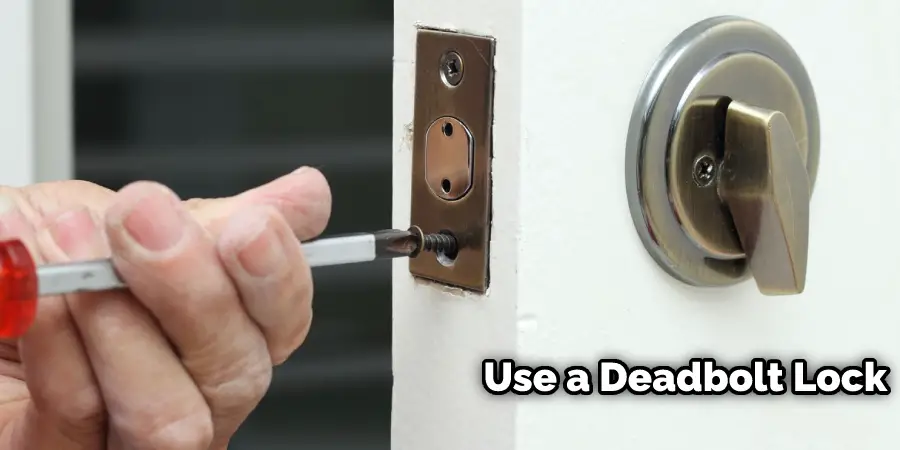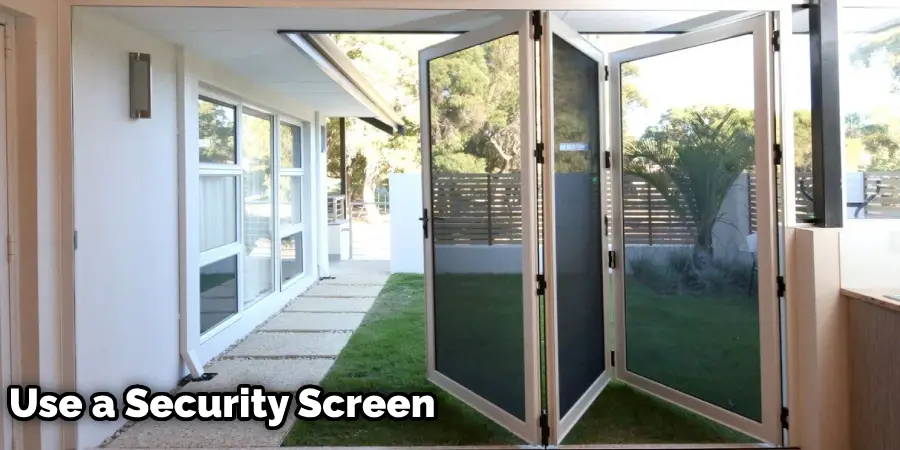Securing an outward-opening door can be tricky, as the nature of the door’s design makes it vulnerable to intruders. However, there are several steps that you can take to ensure your outward-opening door is safe and secure.

From installing a quality deadbolt lock to reinforcing the frame with metal plates or wood dowels, these simple tips will help you keep your home safe and sound from unwanted visitors. With some minor adjustments and a few common household tools, you’ll be able to protect your property from potential break-ins – no matter what type of door you have installed at home! So, keep reading to learn more about how to secure outward opening door.
Why You Need to Know how To Secure Outward Opening Door
Knowing how to secure an outward-opening door is essential for a variety of reasons. Firstly, outward doors will typically provide additional security against intruders. If you are leaving property unattended for any length of time, it is important to know common tactics used by criminals in order to be able to protect your home or property.
Secondly, if you have small children or pets at home, you must be able to secure your front and back doors in case they inadvertently open them without your permission. By securing these types of doors, you can rest easy knowing that everyone inside remains safe and secure.

Finally, knowing how to secure an outward opening door properly may prove to be a life-saving skill one day – especially if disaster strikes and you need a way out quickly. Learning about the different methods for securing these doors now can save you valuable time later on down the road.
Step by Step Guide on How to Secure Outward Opening Door
Step 1: Reinforce the Hinges
The first step to secure an outward-opening door is to reinforce the hinges, which are the weakest point of the door. There are different types of hinges that you can use for this purpose, such as:
- Non-removable pin hinges: These have pins with flattened ends that cannot be removed or popped out. They are also known as fast-riveted hinges and are very durable and resistant to tampering.
- Stud hinges: These hinges have built-in studs that fit into holes on the opposite side of the hinge when the door is closed. They prevent the door from being lifted off the hinges even if the pins are removed.
- Set screw hinges: These hinges have a small hole drilled through the pin and the hinge on the inside part, where a set screw is inserted. The set screw keeps the pin in place and can only be accessed when the door is open.
You can either replace your existing hinges with one of these types or modify them by adding studs or set screws yourself. This will make your outward-opening door much more secure and resistant to forced entry.
Step 2: Install a Deadbolt Lock
The second step to secure an outward-opening door is to install a deadbolt lock, a type of lock inserted into the door frame and can only be opened with a key or a code. A deadbolt lock provides an extra layer of security for your door, as it cannot be easily picked or bumped like a regular lock. You can choose from different types of deadbolt locks, such as:
- Single-cylinder deadbolt: This is the most common type of deadbolt lock, which has a keyhole on one side and a thumb turn on the other. It is easy to use and install, but it can be unlocked from the inside without a key, which can be a safety hazard in case of fire or emergency.
- Double cylinder deadbolt: This type of deadbolt lock has a keyhole on both sides, which means it requires a key to open from either side. It is more secure than a single-cylinder deadbolt, as it cannot be unlocked from the inside without a key, but it can also be a safety hazard in case of fire or emergency, as you may not have access to the key when you need it.
- Keyless deadbolt: This type of deadbolt lock does not require a key to open but instead uses a code, a fingerprint, a card, or a smartphone app. It is very convenient and modern, as you don’t have to worry about losing or forgetting your keys, but it can also be vulnerable to hacking or battery failure.

You can install a deadbolt lock yourself by following the instructions that come with it, or hire a professional locksmith to do it for you. Make sure you choose a high-quality deadbolt lock that meets the standards of security and durability.
Step 3: Use a Security Bar or Wedge
The third step to secure an outward-opening door is to use a security bar or wedge, which is a device that prevents the door from opening by creating friction or pressure against the floor or the wall. A security bar or wedge can be used as an additional measure of security for your door, especially when you are inside the house or away for a long time. There are different types of security bars or wedges that you can use for this purpose, such as:
- Door stopper: This device wedges under the door, creating friction against the floor. It is easy to use and remove but may be ineffective against strong force or leverage.
- Door jammer: This device fits under the door and extends to create pressure against the floor. It is more effective than a door stopper, as it can withstand more force and leverage but may also damage the floor or the door if misused.
- Door brace: This device fits under the door and extends to create pressure against the wall opposite the door. It is similar to a door jammer but uses the wall for greater stability and strength. Use the correct security bar or wedge type for your particular door, as some may be more effective than others. You should also check that it is installed correctly and securely before you leave the house so that it does not become dislodged in case of forced entry.
Step 4: Add Window Film or Security Screens
If your outward opening door has glass panels or windows, you should consider adding window film or security screens. Window film is a thin layer of plastic applied to the glass surface, making it more resistant to shattering or breaking. Security screens are metal mesh screens installed over glass panels or windows, making them more difficult to cut or smash.

Both window film and security screens can enhance the security of your outward-opening door by preventing intruders from breaking through the glass and reaching for the handle or lock. They can also deter potential burglars and give you more peace of mind while away from home.
Step 5: Install Outdoor Motion-Sensing Lights
Installing outdoor motion-sensing lights is the fifth step to securing an outward-opening door. Motion-sensing lights detect movement and turn on a light when someone approaches the area. They can deter potential intruders, as they will alert you of any suspicious activity around your property.
You can install motion-sensing lights on the walls or ceilings of your porch, patio, or any other area near the outward opening door. Make sure to choose a reliable and strong light to deter potential intruders and turn it on when you are away from home.
Step 6: Use a Surveillance Camera
Installing a surveillance camera is the sixth step to securing an outward-opening door. Surveillance cameras are devices that record images or videos of the area around your property and can be used to monitor suspicious activity and deter potential burglars.
You can install a surveillance camera near the outward opening door so that you can watch for any suspicious activity or to be alerted in case of a potential break-in. Make sure to choose a reliable, secure camera with a clear view of the area so that you can get the best possible footage.
Step 7: Employ a Door Barricade
Installing a door barricade is the final step to securing an outward-opening door. A door barricade is a device that can be attached to the inside of the door and prevents it from opening if someone tries to break through. Door barricades come in various shapes and sizes, so choose one that fits your particular doorway and door type.
Where Securing an Outward-Opening Door Is Important
Securing an outward-opening door is an important safety precaution for many reasons. For those living in hurricane-prone areas, such as parts of the US Atlantic coast, ensuring the outward-facing door is well secured can mean the difference between a home standing after a powerful storm and one decimated.
Similarly, people in warmer climates may have to worry about intruders trying to break into their homes via an outward-opening door. With good security measures, such as reinforced locks and sturdy frames, homeowners can rest assured that their outward-facing doors are secure. Moreover, even without these issues being a concern, it’s important to be aware of the importance of properly securing an outward-opening door for privacy and safety reasons.
Frequently Asked Questions
Are Diy Home Security Systems Applicable for Outward Opening Door Security?
Yes, DIY home security systems are applicable for outward-opening door security. Many DIY home security systems offer components such as motion sensors and surveillance cameras to help you secure an outward-opening door. Installing window film and security screens are also great ways to make your outward-opening door more resistant to break-ins.
What Types of Door Barricades Should I Use to Secure an Outward-Opening Door?
You can use a few different types of door barricades to secure an outward-opening door. Depending on the size and configuration of your doorway, you may choose from hinged or sliding barricades, horizontal bars, or even electronic locks.
How to Secure Outward Opening Door from Inside?
A door barricade is one of the best ways to secure an outward-opening door from the inside. Door barricades can be attached to the inside of the door and prevent it from opening if someone tries to break through.
Conclusion
It is essential to ensure that an outward-opening door is securely fastened. By following the steps outlined in this article, you can easily secure your outward-opening door and give yourself peace of mind that your home is safe from intruders. With proper installation and maintenance, your outward-facing door will provide the security you need.
Thanks for reading this article about how to secure outward opening door. We hope this article was informative and helpful in showing you how to secure an outward-opening door properly.
